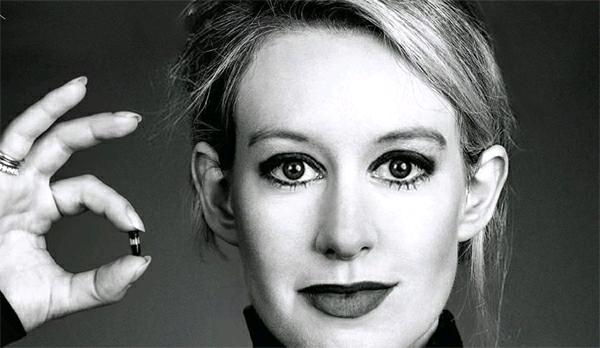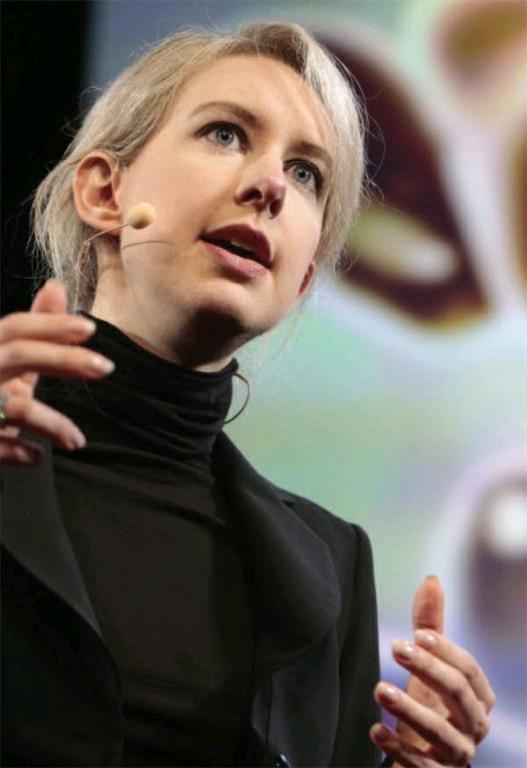科技改变人生:31岁美女富豪炼成记
2016-01-07KimberlyWeisul
Kimberly+Weisul
传统的验血方式总是很不舒服:扎前心情紧张,扎后胳膊疼,采血量大,花的银子多。很多人在抽血时都畅想:若能有更舒适的检测手段该多好!美国一位年轻女性不仅将之化为现实,发明出一种更舒适、更方便、更廉价的血检方式,更借此成为全球最年轻的女富豪,她就是伊丽莎白·霍姆斯。与其他富豪不同,霍姆斯并不急于追求公司的快速扩张,反而更专注于科学,因为在她心里,挽救人类生命才是终极目标。
Youd have to look really hard not to see Steve Jobs in Elizabeth Holmes. Both Holmes and Jobs were loners as kids. Both dropped out of college, in part, because they didnt see the virtue in an education they believed wouldnt make a difference in their futures. Like the Apple creator, Holmes has kept her company Theranos shrouded1) in secrecy. Jobs became a billionaire by the time he was 40. For Holmes, that moment came sooner. When Theranos was valued at $9 billion, she was not yet 31.
Of course, one obvious difference between them is that Holmes is a young woman in an environment that has long favored young men. But there are few entrepreneurs—of either gender—with Holmess record of accomplishment. Holmes didnt set out to become a role model; she set out to save lives. But now, as the worlds youngest female self-made billionaire, shes stumbled into this rarefied2) position and is beginning to own it.
Then there are the black turtlenecks. Most have assumed that Holmess sartorial3) choice is an eerie homage to Jobs. But it turns out, the black turtlenecks were inspired by Sharon Stone4), who wore one to the 1996 Oscar ceremonies. As with many things in Holmess life, shes stayed with the look solely for reasons of efficiency: The turtlenecks eliminate early-morning decision making. Holmes has taken a similar life-hack5) approach to every aspect of her existence outside of her lab test company, which is minimal, given that the 31-year-old works seven days a week. She says she “doesnt really hang out with anyone anymore,” aside from her younger brother. She didnt take a vacation during the entire decade of her 20s and doesnt date. “I literally designed my whole life for this,” says Holmes in a strikingly baritone6) voice, her shoulders curled inward and hands clasped, the body language of someone who is fiercely protective and on guard. Talking to Holmes is a bit like talking to a politician—shes politely impenetrable7), unspooling8) a stream of words without actually revealing very much.
Steve Jobs had massive ambition, but Holmess is arguably larger. While revolutionizing consumer technology is formidable9), Holmes believes her company will actually save lives. Her diagnostic lab test upstart is aiming to disrupt a $75 billion industry, and to help grow it by another $125 billion. Theres the revolutionary nature of its science, as well as the transformational vision of its model. Theranos, now valued at $10 billion, has developed blood tests that detect hundreds of conditions and diseases from a couple of drops of blood from the finger, instead of tubes of blood from a vein in the arm. Holmes aims to enable anyone to get lab tests—for anything from cholesterol to cancer—on his or her own at a local pharmacy for no more than half of what Medicare10) would pay. Holmes believes that providing faster, more convenient, and less expensive access to lab tests will transform preventive medicine.
To get there, Holmes has taken the road less traveled, and what an exceptionally long road that is. Shes already spent a third of her life building an organization that is still in its early days. From its inception11) in 2003, she operated Theranos in stealth mode, bringing it out into the light only a year and a half ago. She thinks another 20 years is a reasonable time frame for her company to impact the masses worldwide. In many ways, she is the opposite of a serial entrepreneur12). Shes a devoutly monogamous13) entrepreneur: For better or worse, in sickness and in health, she sees herself as having only one existential purpose. “Youre talking to someone who wants to do this her whole lifetime,” she says.
Holmes has come a long way14) since ditching Stanford at 20. At the time, there was no model for her to follow; it was 2004, years before dropping out of college and going westward was in vogue, and Holmes was hardly a coder raising money for the next big app. Most biotech founders had PhDs and years of experience; Holmes had neither. She hadnt even stuck around Stanford long enough to get her undergrad degree in chemical engineering.
From a young age, Holmes has always exhibited confidence. She led a solitary childhood, her family moving from Washington, D.C., to Houston, where instead of forging friendships, shed sketch designs for time machines and collect insects. By the time she was a 15-year-old high school sophomore, she was spending her summers in California and had successfully pestered15) Stanfords administrators into allowing her to take a college-level Mandarin class. During her freshman year at Stanford, she nagged Channing Robertson, at the time a dean of engineering, until he let her into his lab, which was populated mostly with PhD students. “She would just stand in my doorway every day and say, ‘When are you going to let me into your lab?” says Robertson.
By the time she got in, Holmes knew she wanted to devote her lifes work to health care. Her ingenuity ultimately led her to the field of testing. The summer before her sophomore year, she worked at the Genome Institute of Singapore, doing SARS testing with traditional methods. At Stanford, shed been exploring lab-on-a-chip16) technology, which enables diverse results to be extracted from a minuscule17) amount of liquid on a microchip. By the time she returned to California in 2003, Holmes had developed a novel drug-delivery device—a wearable patch that could adjust dosage18) according to variables in the patients blood and update doctors wirelessly. She filed it for her first patent.
Holmes soon found herself spending more time talking to venture capitalists than in the classroom, and asked the then 59-year-old Robertson to advise her new company. He demurred19). Hed been involved in about 40 startups, but never, he says, with one run by a 19-year-old. Her parents let her use the money theyd saved for her education as her first seed round of funding. She hired a couple of students from the lab and started building prototypes, and Robertson agreed to become her first adviser.
Even in those early days, it was clear Holmes was designing her company for the long term. She wasnt going to screw it up by building something suitable only for a quick flip, or slapping together20) a company that could be gutted21) by acquirers or investors who didnt share her priorities. Holmes made her task harder by insisting on keeping control of the company, of which she still owns more than half.
Holmess vision is to ultimately have Theranos wellness centers within five miles of every person in the United States—and to provide similar access throughout the world. Although shes a long way from that reality, over the past 18 months the momentum behind Theranos has been building. Theres the recent deal with the prestigious Cleveland Clinic22), which will use Theranos technology to test its patients. In July 2015, Arizona passed the countrys first bill allowing patients to order blood tests without a prescription. And then theres the massive Walgreens23) deal.
Any of Theranoss advances could potentially transform the lab test industry. But Theranoss black-box approach has led to a slew of criticism. Competitors and some in the medical community complain the startup has revealed too little about how its tests work, and have called for Theranos to publish its studies in peer-reviewed journals. Holmes is unapologetic about not giving in to the critics. “I admit its very intentional,” she says. “We dont call on our competitors and explain how our technology works.” Instead, she says, Theranos is asking the Food and Drug Administration24) to approve each of its tests, something no other lab test company has done. In July 2015, it received its first FDA approval, for its herpes simplex25) 1 test.
For a scientist, Holmes has a notable relationship with her faith, drawing on it26) when the weeks in the lab are long and the criticism is loud. “My belief in God has played a huge role in everything that Ive done,” says Holmes. “When you dont have anybody to talk to and when youre going through something thats hard and believing that youre doing that because theres something greater thats going to come from it—that you cant even understand—that gives you the strength to keep going.” Board member Bill Frist says the way Holmes sees it, Theranos is her deeper calling. “Her purpose in life is very much on a different plane,” he says. “For her, its a tunnel. She knows right where she is in the tunnel, and she is dedicated to running through it and not paying much attention to the rest of the world.”
More recently, Holmes has tried dabbling27) with life outside the tunnel. Shes been speaking to groups of girls, encouraging them to excel academically. “This is just one of those areas where a glass ceiling28) shouldnt exist,” she says of entrepreneurship. “We change this for the next generation by our actions.” “It was a long time after I started this company that I realized that there had not been a sole female founder-CEO of a multibillion-dollar health care or technology company,” Holmes says, incredulous. “I didnt believe it. I still dont believe it.”
When it is noted that being “the only woman” can make for a very lonely career, Holmes, who typically has a long, winding answer for everything, replies with just a single word: “Yes.”
你不用仔细观察,就会发现伊丽莎白·霍姆斯身上有史蒂夫·乔布斯的影子。霍姆斯和乔布斯小时候都不合群。他们都从大学辍学,部分原因是他们认为大学教育不会对他们的未来产生影响,他们看不出这种教育有什么益处。像苹果公司的创始人一样,霍姆斯也一直让她的公司Theranos笼罩在神秘之中。乔布斯在40岁时成为亿万富翁。而对霍姆斯来说,这一时刻来得更早一些,当Theranos的估值达到90亿美元时,她还未满31岁。
当然,他们两人的一个明显区别是,霍姆斯是一位在一向对年轻男性有利的环境中打拼的年轻女性。不过,无论男性还是女性,很少有企业家达到她这样的成就。霍姆斯的出发点并不是要成为楷模,而是要拯救生命。但如今,作为全球最年轻的白手起家的亿万女富豪,她意外地站在了这个远超常人的位置上,并开始拥有这一身份。
还有她的黑色高翻领毛衣。大多数人都想当然地认为霍姆斯在着装上的选择是在以一种诡异的方式向乔布斯致敬。但实际上,她这样穿是受莎朗·斯通的启发,后者曾身着一件黑色高翻领毛衣出席1996年的奥斯卡颁奖礼。跟她生活中的很多事一样,霍姆斯之所以保持着这样的装束仅仅是出于效率上的考虑:有了高翻领毛衣,早上就不必花时间决定穿什么衣服了。在她实验室检测公司的工作之外,霍姆斯对自己生活的各个方面采取的都是类似的简单省时的方式。考虑到31岁的她每周工作七天,这种工作之外的生活其实微乎其微。她说,除了弟弟之外,她“基本上不再和任何人一起消磨时光”。在二字头的年龄,她整整十年没有休过一次假,也从不约会。“我真的打算一辈子都做这件事。”霍姆斯的嗓音异常低沉,她肩膀略向内收,双手紧握,这样的肢体语言表明她的防护意识和戒备心非常强。同霍姆斯交谈有点像跟政治家谈话—她虽然礼貌,但很难让人看透,滔滔不绝能讲一连串的话,但其实没有透露太多信息。
史蒂夫·乔布斯雄心勃勃,而霍姆斯的志向可以说更为远大。虽然彻底变革消费类技术这项工作艰巨得让人望而生畏,但霍姆斯认为她的公司真的能够挽救生命。作为诊断实验室检测行业的业界新贵,她的公司旨在打破这个有着750亿美元规模的行业的现状,并帮助其再增长1250亿美元。不仅Theranos实验室检测的模式具有变革性的前景,而且其所用的科技也具有革命性特点。Theranos公司如今的估值为100亿美元。该公司开发的验血技术不必从手臂静脉抽取好几试管的血液,只需从手指上采集几滴血就能进行成百上千种健康状况及疾病的检测。霍姆斯的目标是使人人都能够以不超过医保支付额一半的费用在当地药店自行进行检测,检测涵盖从胆固醇水平到癌症的各个项目。霍姆斯相信,提供更为快速、便捷和廉价的检测方式将会改变预防医学的面貌。
为了达到这一目标,霍姆斯选择了一条少有人走的路,那是一条极其漫长的路。她用人生三分之一的时间创建的这家公司仍处于起步阶段。从2003年Theranos成立伊始,她一直秘密地经营着这家公司,直到一年半以前,才将它带入公众的视野。霍姆斯认为,她的公司要想在全世界范围内影响民众生活,还需要20年时间—这是一个合理的时间预期。她在很多方面都与那些连续创业者截然不同。她是个一心一意要从一而终的企业家:无论顺境还是逆境,无论健康还是疾病,她都认为自己生存于世只有一个目的。“正在和你谈话的是一个想把一生都献给这项事业的人。”霍姆斯说道。
自20岁从斯坦福大学退学后,霍姆斯的事业取得了很大进展。当时并没有可让她效仿的榜样。那是2004年,从大学退学去西部创业还要有几年才会流行起来,而霍姆斯也不是那种为下一个大热的app筹集资金的程序员。大多数生物科技公司的创始人都有博士学位和数年从业经历,而霍姆斯两者皆无。她在斯坦福求学的时间不够长,连化学工程专业的本科学位都没拿到。
霍姆斯从小就一直表现得很自信。她的童年很孤独。她和家人从华盛顿特区搬到休斯顿后,她没有去结交朋友,反而把时间花在画时光机的设计草图和收集昆虫上。在她15岁读到高二时,她有几个夏天是在加州度过的,并且软磨硬泡地成功说服斯坦福校方准许她修读一门大学水平的中文课程。在斯坦福读大一时,她没完没了地缠着当时工程学院的院长钱宁·罗伯逊,直到他让她进入他的实验室,而当时实验室里基本上都是博士生。“她每天就站在门口问我:‘什么时候让我进您的实验室?”罗伯逊说。
一进入实验室,霍姆斯就知道,她想把自己毕生之力奉献给医疗保健事业。她的聪明才智最终指引她来到了检测这一领域。大二前的那个夏天,她去了新加坡基因组研究所工作,利用传统方法进行非典检测。在斯坦福时,她已经在探索芯片实验室技术,这种技术能够利用一块微芯片从极少量的液体中获得多项检测结果。2003年,霍姆斯回到加州时,她已经开发出一种新型给药装置—一块能够根据患者血液指标的变化调整药量并向医生无线发送最新情况的贴片。她为这项发明申请了她的第一项专利。
霍姆斯很快就发现她与风险投资人谈合作的时间比她上课的时间还要多。她邀请时年59岁的罗伯逊当她新公司的顾问。他拒绝了。他说他参与了大约40家创业公司的工作,但是没有哪一家是由一个19岁的年轻人掌舵的。霍姆斯的父母同意把他们为她积攒的教育资金作为她的第一轮种子融资。她从实验室雇了几个学生,开始制作产品原型。罗伯逊最终同意当她的首位顾问。
即使在创业初期也能明显看出,霍姆斯对她的公司是有长远规划的。她不想开一个只适合短期发展的公司,或者草草拼凑一个公司,让那些和她没有共同首要目标的收购者和投资人把公司掏空,那样的话就搞砸了。她坚持掌握公司的控制权,目前她的持股比例仍然超过50%,这让她的任务变得更加艰巨。
霍姆斯的愿景是最终将Theranos健康中心开到距离每个美国人不到五英里的地方,并在全球范围内达到相似的普及程度。尽管离实现这个目标还有很长一段路要走,但在过去的18个月中,Theranos的发展势头一直在增长。该公司最近与享有盛名的克利夫兰医学中心达成协议,后者将使用Theranos的技术为患者做检测。2015年7月,亚利桑那州通过了全美第一个允许患者无需处方即可要求验血的法案。此外还有与沃尔格林公司达成的巨额交易。
Theranos取得的每一步进展都有可能改变医学检测行业。但其秘而不宣的做法却招致了大量批评。Theranos的竞争对手以及部分医疗从业人员抗议说,这家创业公司对于其检测方式的工作原理透露得太少,他们要求Theranos将其研究发表在同行评审的期刊上。霍姆斯没有向批评者让步,也不为此感到抱歉。“我承认这样做是有意为之,”她说,“我们不会去拜访我们的竞争对手,向他们解释我们的技术如何起作用。”与此相反,她表示,Theranos正在请美国食品药品监督管理局(FDA)对公司的每一项检测技术进行认证,这是其他医学检测公司从未做过的。2015年7月,Theranos的单纯疱疹病毒一型的检测产品获得了首个FDA认证。
作为一名科学家,霍姆斯与其信仰的关系值得关注。实验室的工作漫长,外界的批评声响亮,每当这时她都会诉诸信仰。“我对上帝的信仰在我所做的每一件事中都起到了巨大的作用,”霍姆斯说,“当你无人可以倾诉,当你正在经历困难,并相信自己之所以这样做是因为从中会产生更伟大的事物(即使你无法理解),那么这种信仰会给你坚持下去的力量。”公司董事会成员比尔·弗里斯特表示,在霍姆斯看来,Theranos代表着她内心更深层次的使命感。“她的人生目标与常人大不相同,”他说,“对她而言,人生就是一条隧道。她知道自己在这条隧道中的确切位置,她一心想穿过这条隧道,不太在意世界上的其他事。”
最近,霍姆斯开始尝试涉足“隧道”之外的生活了。她为女生团体演讲,鼓励她们在学术上出类拔萃。“学术领域不过是不应该存在‘玻璃天花板的领域之一,”谈及创业时她这样表示,“我们要通过自己的行动为下一代改变这种现状。”“创办这家公司很久之后我才发现,在估值超过10亿美元的医疗保健或科技公司中,从未有过一位女性创始人兼CEO。”霍姆斯说道,觉得不可思议,“当时我不相信,现在依然无法相信。”
当被指出作为这“唯一的女性”意味着她的职业道路会十分孤独时,通常以冗长迂回的方式回答所有问题的霍姆斯只用了一个词作答:“是的。”
1. shroud [?ra?d] vt. 掩盖;掩饰;掩藏
2. rarefied [?re?r?fa?d] adj. 脱离普通人和现实生活的
3. sartorial [sɑ?(r)?t??ri?l] adj. 服装的;衣着的
4. Sharon Stone:莎朗·斯通(1958~),美国演员,代表作为《本能》(Basic Instinct)。
5. life-hack:能提高效率的;简单省时的
6. baritone [?b?r??t??n] adj. 男中音的
7. impenetrable [?m?pen?tr?b(?)l] adj. 费解的;难以理解的
8. unspool [??n?spu?l] vt. (从线轴上)解开
9. formidable [?f??(r)m?d?b(?)l] adj. 令人望而生畏的;艰巨的
10. Medicare:(美国的)老年医疗保险制度(指政府为65岁以上老人设置的医疗费减免制度)
11. inception [?n?sep?(?)n] n. 开端;初期
12. serial entrepreneur:连续创业者(接二连三创立新公司的企业家)
13. monogamous [m??n?ɡ?m?s] adj. 一夫一妻(制)的
14. have come a long way:取得进步,取得进展
15. pester [?pest?(r)] vt. 不断烦扰;纠缠
16. lab-on-a-chip:芯片实验室,是一种在芯片上完成不同反应并对其产物进行分析的技术。
17. minuscule [?m?n??skju?l] adj. 极小的,微小的
18. dosage [?d??s?d?] n. (药的)剂量,用量
19. demur [d??m??(r)] vi. 提出异议;拒绝
20. slap together:草草拼凑
21. gut [ɡ?t] vt. 抢劫;劫掠
22. Cleveland Clinic:克利夫兰医学中心,美国顶尖的综合医疗机构,其心脏和心血管外科专业连续18年位列全美第一。
23. Walgreens:沃尔格林公司,美国一家食品、药品零售连锁企业
24. Food and Drug Administration:美国食品药品监督管理局(简称FDA)
25. herpes simplex:[医]单纯疱疹
26. draw on sth.:利用,依赖(信息或知识)
27. dabble [?d?b(?)l] vi. 涉猎;浅尝
28. glass ceiling:玻璃天花板(喻指职务晋升中无法逾越的隐形限制)
